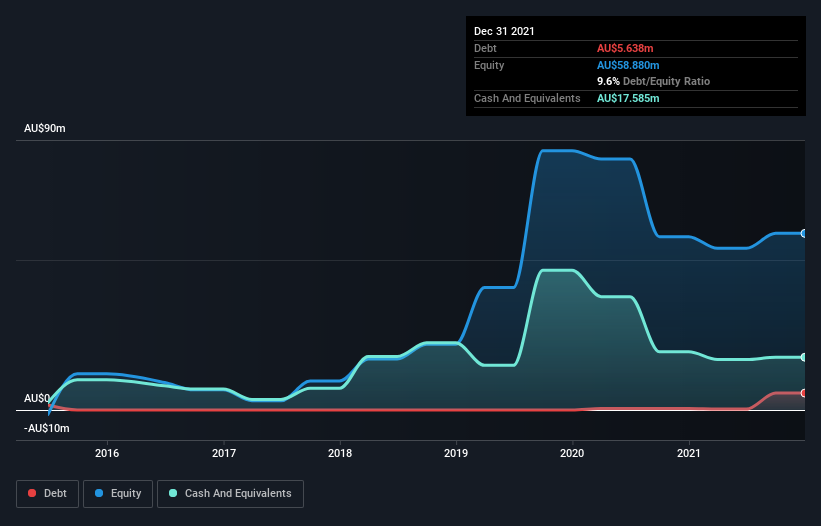Is LiveTiles (ASX:LVT) A Risky Investment?
Legendary fund manager Li Lu (who Charlie Munger backed) once said, 'The biggest investment risk is not the volatility of prices, but whether you will suffer a permanent loss of capital.' When we think about how risky a company is, we always like to look at its use of debt, since debt overload can lead to ruin. As with many other companies LiveTiles Limited (ASX:LVT) makes use of debt. But the real question is whether this debt is making the company risky.
What Risk Does Debt Bring?
Generally speaking, debt only becomes a real problem when a company can't easily pay it off, either by raising capital or with its own cash flow. Part and parcel of capitalism is the process of 'creative destruction' where failed businesses are mercilessly liquidated by their bankers. However, a more frequent (but still costly) occurrence is where a company must issue shares at bargain-basement prices, permanently diluting shareholders, just to shore up its balance sheet. Of course, plenty of companies use debt to fund growth, without any negative consequences. The first step when considering a company's debt levels is to consider its cash and debt together.
See our latest analysis for LiveTiles
How Much Debt Does LiveTiles Carry?
The image below, which you can click on for greater detail, shows that at December 2021 LiveTiles had debt of AU$5.64m, up from AU$463.9k in one year. But it also has AU$17.6m in cash to offset that, meaning it has AU$11.9m net cash.
How Healthy Is LiveTiles' Balance Sheet?
We can see from the most recent balance sheet that LiveTiles had liabilities of AU$33.5m falling due within a year, and liabilities of AU$22.0m due beyond that. Offsetting this, it had AU$17.6m in cash and AU$8.45m in receivables that were due within 12 months. So it has liabilities totalling AU$29.5m more than its cash and near-term receivables, combined.
LiveTiles has a market capitalization of AU$80.8m, so it could very likely raise cash to ameliorate its balance sheet, if the need arose. But it's clear that we should definitely closely examine whether it can manage its debt without dilution. While it does have liabilities worth noting, LiveTiles also has more cash than debt, so we're pretty confident it can manage its debt safely. There's no doubt that we learn most about debt from the balance sheet. But it is future earnings, more than anything, that will determine LiveTiles's ability to maintain a healthy balance sheet going forward. So if you want to see what the professionals think, you might find this free report on analyst profit forecasts to be interesting.
In the last year LiveTiles wasn't profitable at an EBIT level, but managed to grow its revenue by 28%, to AU$51m. With any luck the company will be able to grow its way to profitability.
So How Risky Is LiveTiles?
We have no doubt that loss making companies are, in general, riskier than profitable ones. And the fact is that over the last twelve months LiveTiles lost money at the earnings before interest and tax (EBIT) line. Indeed, in that time it burnt through AU$4.4m of cash and made a loss of AU$7.3m. But at least it has AU$11.9m on the balance sheet to spend on growth, near-term. With very solid revenue growth in the last year, LiveTiles may be on a path to profitability. Pre-profit companies are often risky, but they can also offer great rewards. The balance sheet is clearly the area to focus on when you are analysing debt. But ultimately, every company can contain risks that exist outside of the balance sheet. We've identified 3 warning signs with LiveTiles , and understanding them should be part of your investment process.
When all is said and done, sometimes its easier to focus on companies that don't even need debt. Readers can access a list of growth stocks with zero net debt 100% free, right now.
Have feedback on this article? Concerned about the content? Get in touch with us directly. Alternatively, email editorial-team (at) simplywallst.com.
This article by Simply Wall St is general in nature. We provide commentary based on historical data and analyst forecasts only using an unbiased methodology and our articles are not intended to be financial advice. It does not constitute a recommendation to buy or sell any stock, and does not take account of your objectives, or your financial situation. We aim to bring you long-term focused analysis driven by fundamental data. Note that our analysis may not factor in the latest price-sensitive company announcements or qualitative material. Simply Wall St has no position in any stocks mentioned.

 Yahoo Finance
Yahoo Finance 
